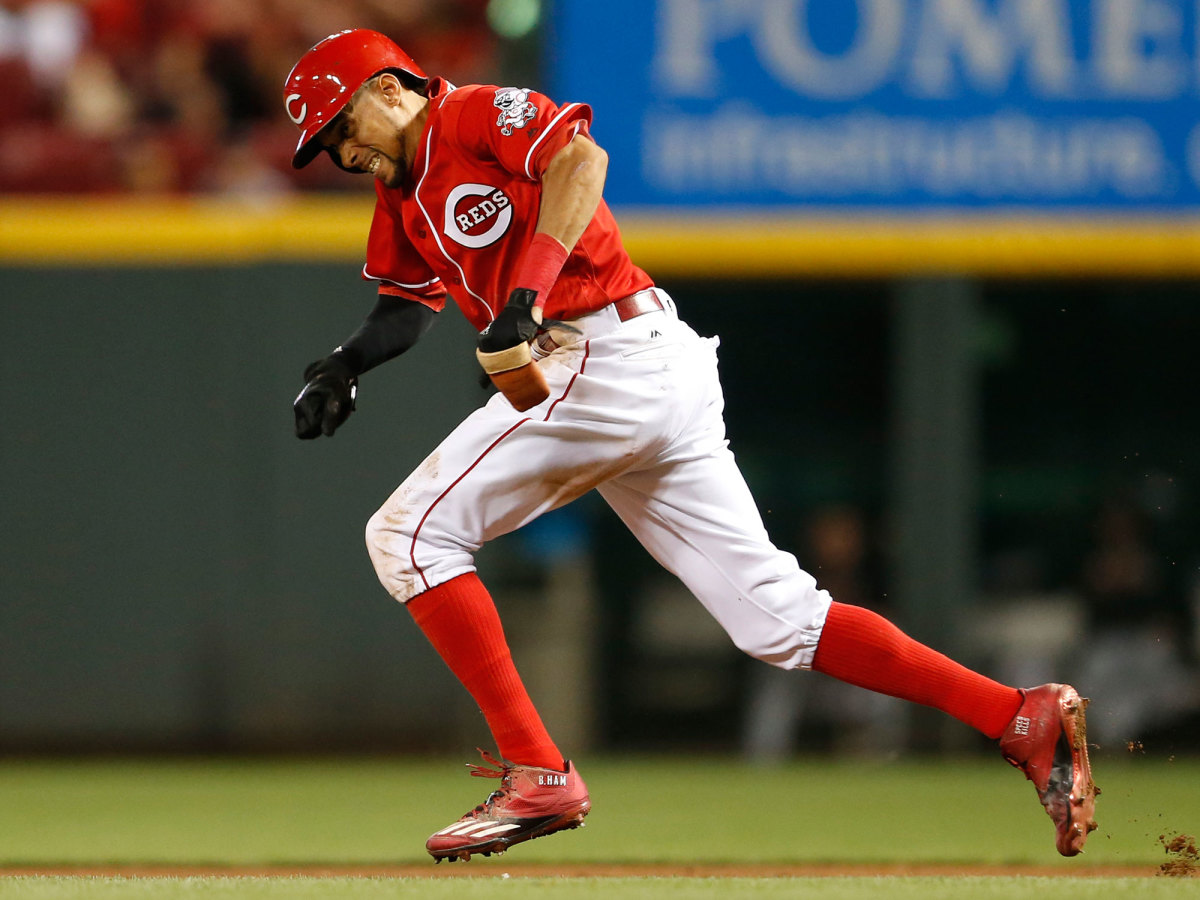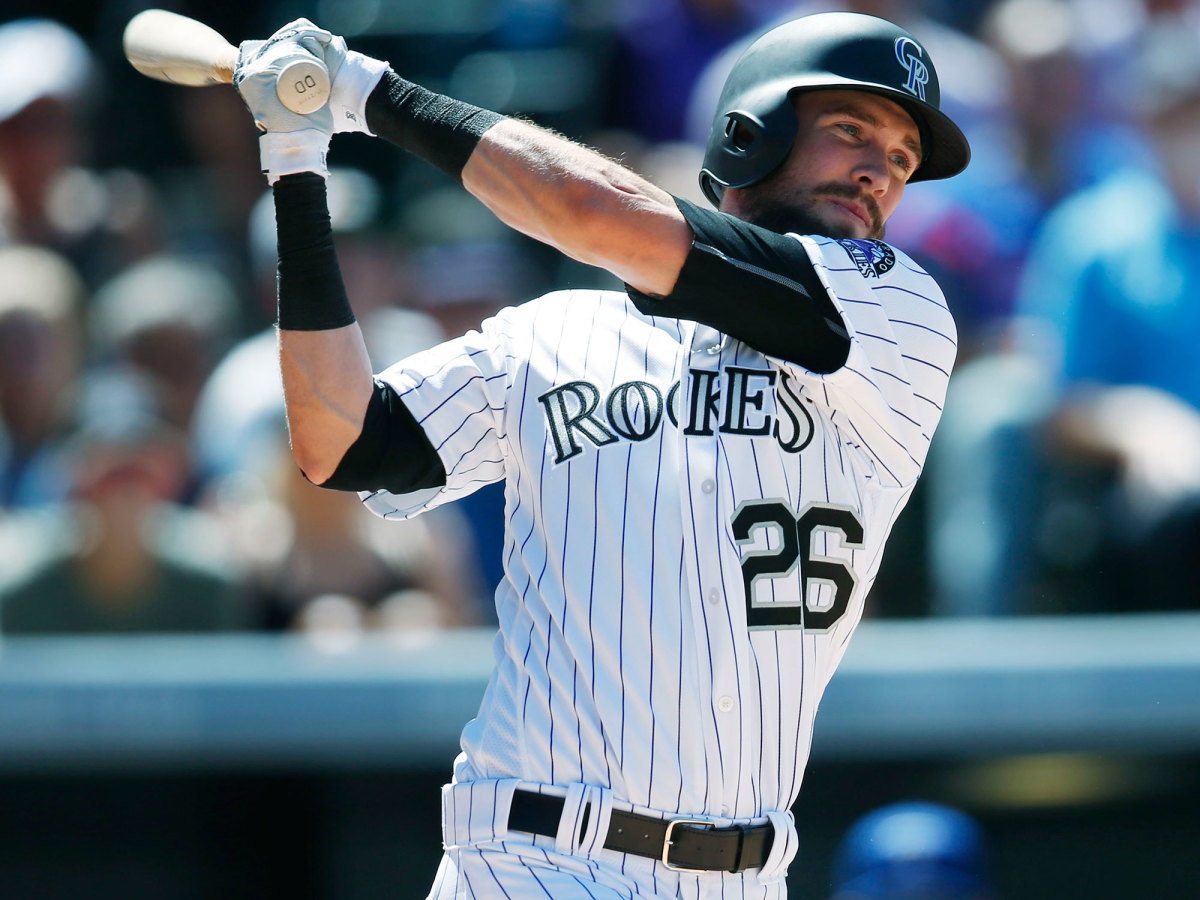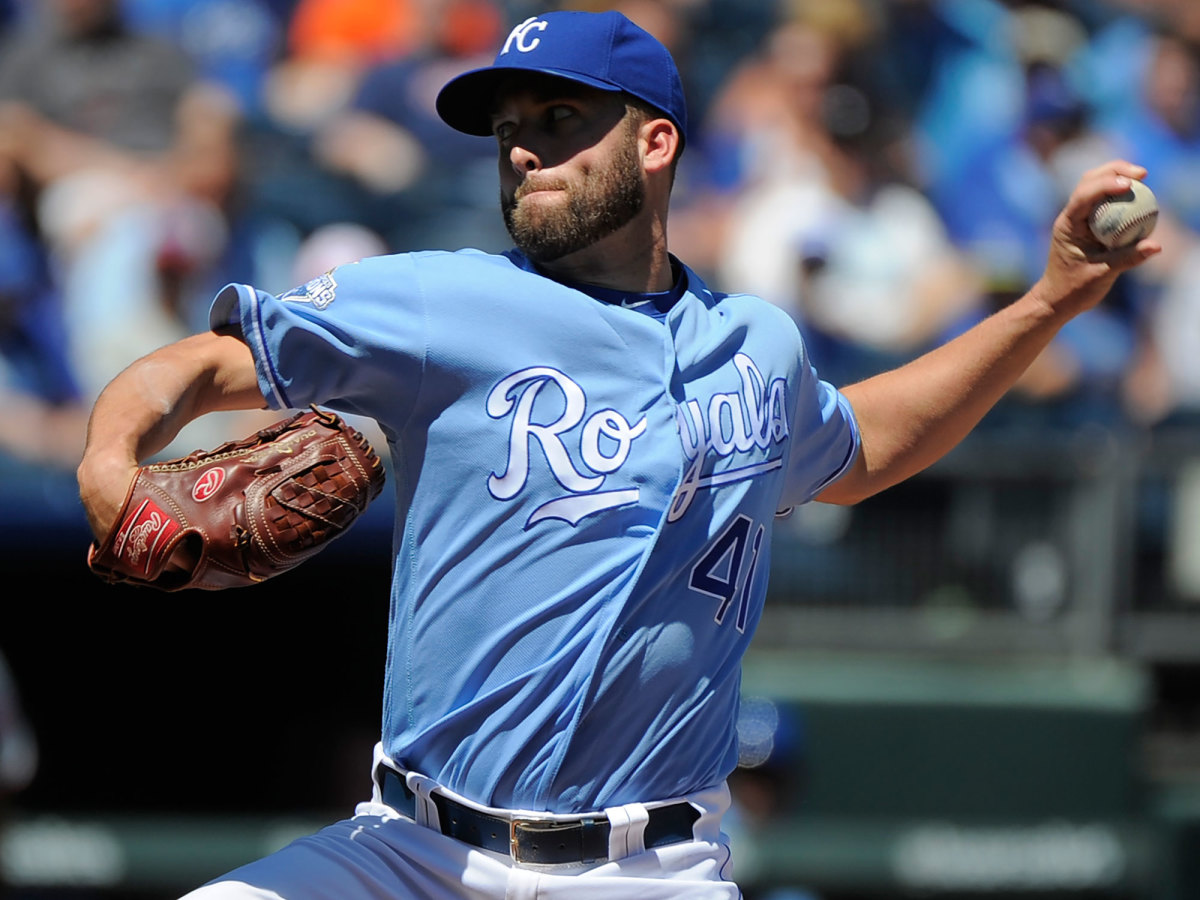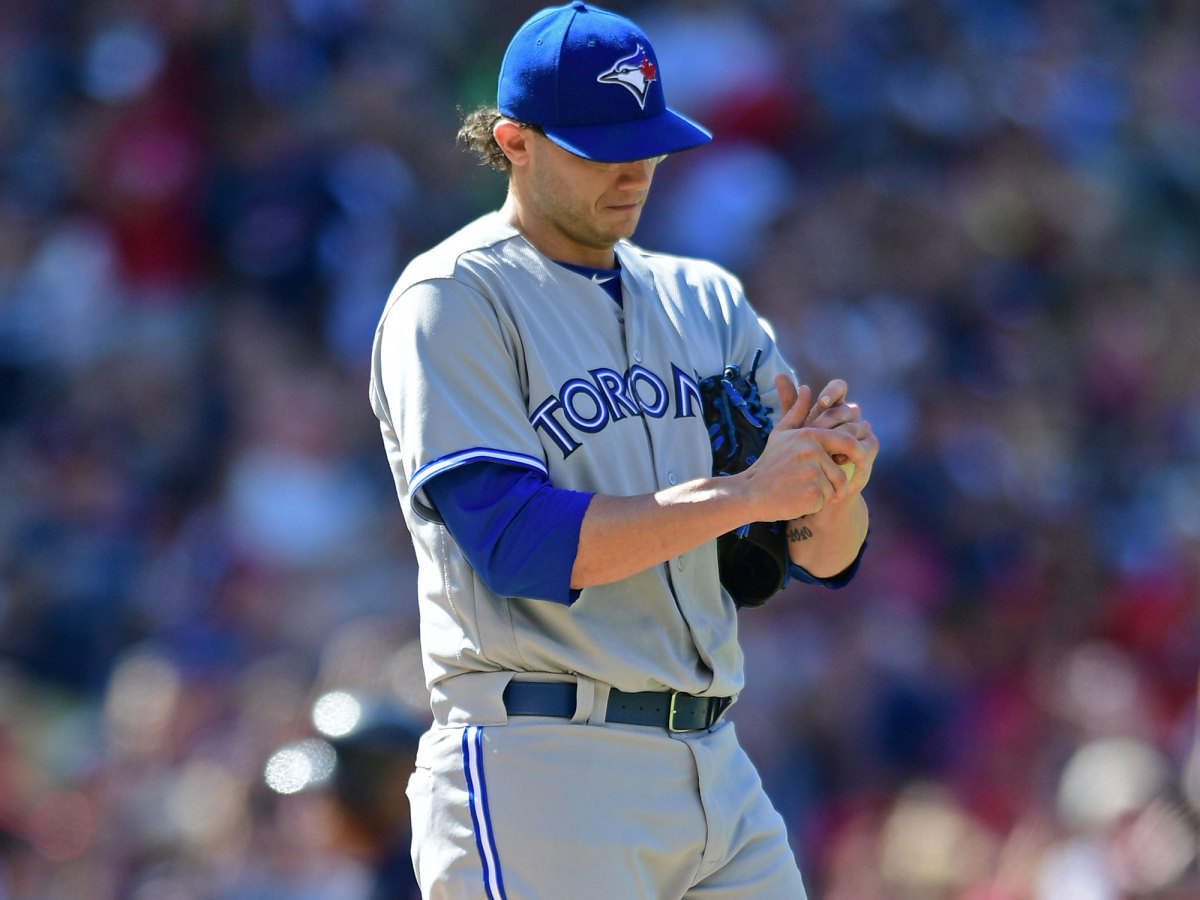The 30: Four teams creating late-summer drama in this week's rankings

August can be a rough month to be a baseball player. Dating back to the start of spring training, you’ve been diving after liners in the gap and snapping off curveballs for six months. When a day game after a night game comes along in 97-degree weather, it’s easy to feel a little less sharp or to lose that normal jolt of energy.
But the beautiful thing about baseball is you never know when drama will find you. Though the spotlight shines brightest in October, the season’s dog days can bring us unforgettable moments, both uplifting and heartbreaking.
This week’s four featured teams are all generating some of that late-summer drama, even if wins don’t always come with it. Billy Hamilton gives the Reds the most electrifying banjo hitter the game has seen in years. David Dahl adds another rookie to the Rockies’ bumper crop. The Royals have ridden a huge winning streak right back into wild-card contention. And the Blue Jays are trying to shake off a roller-coaster series in Cleveland that could be a playoff preview.
The dog days are about to be over. It’s Week 20 of The 30.
Best Disregard For History: Jacoby Ellsbury
When former single-season home-run record holder Mark McGwire played his final season in 2001, he was joined on the roster by another hulking slugger, a kid just starting his own career of attacking the all-time homer leaderboards. A decade and a half later, the career home run list has a logjam at No. 10. That’s where we find McGwire tied with Albert Pujols, at 583.
On Sunday, Pujols looked like he would vault ahead of his former Cardinals teammate. Facing Yankees rookie Chad Green, the Angels' veteran first baseman got a fastball down and in and crushed it. The ball sliced through the hot Orange County sky, looking destined to clear the fence in straightaway center and give Pujols his 584th career long ball.
Jacoby Ellsbury is in the midst of his second straight miserable season as a Yankee. Arguably the best player in the American League five years ago, he’s now a punchless hitter as he nears his 33rd birthday and a conspicuous albatross on a team that’s ushering in exciting young players like Gary Sanchez and Aaron Judge and bidding goodbye to other high-priced veterans.
But Ellsbury can still go get ‘em in center. Tracking Pujols’s deep drive, the Yankees' centerfielder found the wall behind him, braced himself, leaped ... and forced No. 584 to wait for another day.
.@JacobyEllsbury straight up robbed Albert Pujols: https://t.co/yAcIVbJZ0c pic.twitter.com/iVW1PvTMfs
— MLB (@MLB) August 21, 2016

Speed Kills
Billy Hamilton still can’t hit. It might not matter.
30. Atlanta Braves (45–79 record, minus-153 run differential, last week: 30)
29. Minnesota Twins (49–75, minus-99, LW: 28)
28. Arizona Diamondbacks (51–73, minus-129, LW: 29)
27. Oakland A’s (53–71, minus-101, LW: 23)
26. Los Angeles Angels (52–72, minus-43, LW: 25)
25. San Diego Padres (53–71, minus-58, LW: 24)
24. Milwaukee Brewers (53–70, minus-86, LW: 22)
23. Cincinnati Reds (53–70, minus-107, LW: 27)
22. Tampa Bay Rays (52–70, minus-14, LW: 26)
Baseball America’s scouting report on Billy Hamilton entering his 2014 rookie season wasn’t subtle, particularly when it came to his bat.
The questions about Hamilton revolve around his hitting. He will never have more than 30-grade power. Hamilton’s game centers on slapping line drives and dropping bunts, though Triple-A pitchers were able to overpower him at times last year, especially when he hit lefthanded.
Three years later, that analysis looks spot on. In 1,492 career plate appearances, Hamilton has batted .248/.297/.338. Of the 282 hitters with 1,000 or more PA over that span, only nine have fared worse. Two pitchers (Madison Bumgarner and Zack Greinke) have actually outslugged him during that stretch.
Hamilton’s flaccid bat doesn’t begin to describe his value to the Reds, however. Here’s what the rest of that BA report had to say:
Hamilton’s speed is the stuff of legend. Multiple scouts describe him as the fastest player they’ve ever seen, with one noting that he and others have timed Hamilton at just under three seconds from first to second base on steals, faster than Rickey Henderson was in his prime. Hamilton made a quick transition from shortstop to centerfield. While his jumps and routes can continue to improve, he has the speed to outrun mistakes.
Nailed it, again. Even with that weak bat, Hamilton has been the ninth-most valuable centerfielder in the majors since Opening Day 2014. Over that period of nearly full seasons, Hamilton has saved 33 more runs than the average centerfielder—fifth-best in baseball, per Baseball Info Solutions. His highlight reel is full of spectacular catches, plays made not by extraordinary routes or a polished approach, but by sheer, unbelievable closing speed.
But it’s Hamilton’s exploits on the base paths that have made him so much fun to watch. In a nine-game span stretching from Aug. 3 through Aug. 12, he stole 15 bases—more than the Orioles as a team had the entire season to that point. In an era in which stats-savvy teams recognize how much making outs on the bases can hurt them and thus discourage a run-happy approach, Hamilton has topped 50 steals in each of his first three seasons (despite missing 48 games last year) and is on pace to steal an even 70 this year. That would make him just the fourth player to bag 70 bags in a season in the 21st century.
Harper, Trout diverge again as one struggles and one chases an MVP award
Here’s the kicker: Hamilton’s perpetual inability to hit the ball hard would seem like a major handicap to just about any hitter. But as Fangraphs writer August Fagerstrom recently showed, in Hamilton’s case, weak contact is often a feature, not a bug. As Fagerstrom noted, the league as a whole is hitting just above .120 on ground balls with an exit velocity of 80 mph or slower this year; Hamilton is batting nearly .300 on those same weak choppers. He’s one of baseball’s most prolific infield-hit machines, a threat to reach first—and then quickly scoot to second—every time he merely makes contact.
The Reds would surely like to see Hamilton learn to hit the ball with more authority at some point. But by merely living up to his warning sign-filled scouting report, he’s become a borderline All-Star contributor anyway. Blink, and you’ll miss him.

Raking Rookie
David Dahl adds to an already loaded first-year class for the Rockies.
21. Philadelphia Phillies (58–67, minus-120, LW: 21)
20. Chicago White Sox (59–64, minus-45, LW: 19)
19. Colorado Rockies (60–64, plus-18, LW: 20)
18. New York Mets (62–62, minus-10, LW: 17)
17. New York Yankees (63–60, minus-29, LW: 16)
Spending big money for elite talent on the free-agent market can have its advantages. Teams like the 2001 Diamondbacks relied heavily on high-priced, veteran players and rode that formula to a World Series trophy. Still, most of baseball’s best teams have largely done it the old-fashioned way: by developing top-notch, homegrown talent, often with multiple young stars coming up at once.
When it comes to rookie classes, few teams this season can rival the one put forth by the Rockies. In shortstop Trevor Story (out for the year due to a thumb injury), catcher Tony Wolters, starters Jon Gray and Tyler Anderson and (since demoted) reliever Carlos Estevez, Colorado had already ushered in arguably the best freshman class in franchise history. While that sextet wasn’t going to power a playoff run this season, Rockies fans could at least see the contributions of this year’s group of rookies, combined with roster mainstays like third baseman Nolan Arenado, and imagine a brighter future. The success of Gray, Anderson and other young pitchers in particular has spurred optimism over Colorado’s pitching staff, something that we haven’t seen in Denver since ... well, never.
The newest addition to the rookie wave has also been one of the most impressive of the bunch. Leftfielder David Dahl made his major league debut on July 25 in Baltimore, where he went 1 for 4. That modest beginning launched a historic streak, one that saw Dahl hit safely in his first 17 major league games, tying a 75-year-old MLB record.
Baby Bombers: Aaron Judge, Gary Sanchez giving Yankees reason for optimism
We’ve seen enough Shane Spencers, Sam Horns and Kevin Maases to know that big starts to careers don’t always lead to years of success down the road. But Dahl comes from different stock. A first-round pick in the 2012 draft, he’s been pegged as a potential five-tool star from day one. What held him back at first were major injuries: a torn hamstring in 2013 that cost him most of that season and a nasty outfield collision last year that ended with him losing his spleen. In between injuries, Dahl started to make good on that potential, batting .310/.357/.513 in 367 minor league games (including 92 strong games in Double and Triple A at the start of this season) to go along with 20-steals-a-season speed and plus defense. While the sample size is small and the effects of Coors Field well known, Dahl’s .330/.385/.560 line through his first 26 games adds even more excitement for the future.
With the Rockies on pace for their best result in six years and the prospect of sophomore glory next season for the team’s first-year players, Colorado's focus could shift to that other key pillar of team-building. Lefty Jorge de la Rosa’s $12.5 million in largely wasted spending is coming off the books at season’s end, and there's just one more year of painful payouts left for departed shortstop Jose Reyes. Colorado, then, should have some financial flexibility this winter. Sure, the Rockies are still a mid-market team, the coming free-agent market could be relatively weak, and bargain-priced roster pieces like catcher Nick Hundley and first baseman Mark Reynolds are set to become free agents themselves. That said, with recently recalled top pitching prospect Jeff Hoffman now in the mix, the best left side of an infield in the National League and further maturation for the young pitching staff, the Rockies have some serious sleeper potential for 2017 and beyond.

The Duffman Cometh
Danny Duffy has keyed an eight-game winning streak for the Royals, propelling them back into the playoff hunt.
16. Kansas City Royals (64–60, minus-23, LW: 18)
15. Pittsburgh Pirates (62–59, plus-2, LW: 15)
14. Houston Astros (64–60, plus-46, LW: 13)
13. Detroit Tigers (65–59, plus-9, LW: 11)
12. Miami Marlins (65–59, plus-14, LW: 14)
11. San Francisco Giants (68–56, plus-49, LW: 6)
10. St. Louis Cardinals (66–57, plus-81, LW: 12)
9. Seattle Mariners (66–57, plus-51, LW: 10)
8. Baltimore Orioles (67–56, plus-18, LW: 5)
7. Los Angeles Dodgers (68–55, plus-59, LW: 9)
Just when you think they’re out, they puuuullll you back in.
After looking all but dead in the water a week ago, the Royals are back in the thick of a playoff race: They’ve won eight in a row to climb to four games over .500 and now trail the wavering Orioles by just 3 1/2 games in the battle for the AL’s second wild-card spot. But while Kansas City's modus operandi during its back-to-back pennant-winning seasons of 2014 and '15 revolved largely around a shutdown bullpen, the Royals have something else going for them this year: a young, bona fide ace. In a league loaded with big-name pitchers like Felix Hernandez, Chris Sale and Corey Kluber, it’s Danny Duffy who’s surged to second in the AL in ERA this season, with a 2.66 mark that trails only Detroit’s Michael Fulmer (another unlikely success story who looks like a lock to win Rookie of the Year honors).
Let’s get the biggest caveat out of the way first: A massive 84.1% of the runners Duffy has put on base have ended up getting stranded—a sky-high mark that trails only Royals teammate Ian Kennedy and reminds us that both the Kansas City bullpen and the Royals' voodoo of 2014–15 remain largely intact. That aside, Duffy has come by his dominance honestly. The 27-year-old lefthander ranks second among all qualified AL starters in both strikeout rate and strikeout-to-walk rate, with 147 punchouts and just 29 walks in 138 2/3 innings. He also ranks second in swinging-strike rate and second in preventing contact on pitches in the strike zone. Opponents are batting near the Mendoza line on both his four-seam fastball and slider and just .134 on his changeup.
Zach Britton for Cy Young? The case against the Orioles' closer
You can try to punch a few holes in Duffy's nasty performance if you want. His fastball velocity is down a tick in August; his recent strikeout numbers look pedestrian after you strip out his 16-strikeout masterpiece against the Rays on Aug. 1; and Duffy hasn’t yet shown he can be a true April-to-October workhorse in the rotation as he nears his 2014 major league high of 149 1/3 innings pitched. Still, let’s not get too cute here. Duffy has allowed one run or fewer in five of his past seven starts and two runs or fewer in nine of his past 11. He’s also fired six or more innings in of those past 11 outings, turning the game over to that still very good pen.
The question for the Royals becomes where they go from here with the rest of the roster. Second base in particular remains a big hole, with Omar Infante tossed overboard, the Whit Merrifield Experiment ending quickly and highly-touted rookie Raul Mondesi Jr. looking like a better bet for future success than immediate impact. Still trailing three teams in the race for that second wild-card spot and with the non-waiver trade deadline past, the Royals can’t and won’t pull off anything close to their dual acquisitions of Ben Zobrist and Johnny Cueto last July. But with those eight straight wins in the bank and a battle-tested team back in the playoff hunt, a moderate upgrade or two could make tons of sense between now and month’s end.
As the baseball world now knows all too well, the Royals can be hard to kill. If they also have a sustainably excellent homegrown ace on their hands, that’s a scary thought for the rest of the league, both now and in the years to come.

Close, But No Cigar
The Jays continue to be curiously terrible in one-run games.
6. Texas Rangers (73–52, plus-1, LW: 7)
5. Boston Red Sox (69–54, plus-116, LW: 8)
4. Toronto Blue Jays (70–54, plus-95, LW: 3)
3. Cleveland Indians (71–51, plus-105, LW: 4)
2. Washington Nationals (73–50, plus-145, LW: 2)
1. Chicago Cubs (78–45, plus-208, LW: 1)
Players are taught a simple lesson when they make it to the Show: If you want to survive the grind of a 162-game season, don’t get too high after wins or too low after losses. After a thrilling series against one of the best teams in the league ended in bitter disappointment, let’s hope the Blue Jays have taken that lesson to heart.
After winning 18 of its first 29 games post-All-Star break, Toronto dropped two of three over the weekend to the Indians, with each of the three games getting decided by one run. Even that doesn’t fully describe the frustration the Jays must have felt, nor how close the games were. On Friday, Cleveland stormed back with two runs in the bottom of the ninth, toppling the Jays, 3–2, in a spectacularly unlikely way: with an inside-the-park–walk-off home run. After tying the series on Saturday, the Jays looked like they might take the rubber game on Sunday. But a dubious third-strike call against Edwin Encarnacion with the bases loaded in the seventh prevented Toronto from padding its one-run lead, and an absolute meatball served up by flammable lefty Brett Cecil led to a game-winning–two-run homer by Jose Ramirez in the eighth.
As Jose Altuve reaches 1,000 hits, what are his chances at 3,000?
Toronto's brass must now figure out if those two crushing losses (and the related opportunity to create some breathing room in the AL East) constitute a trend or just the usual hiccups that a good team shakes off between 1 and 162. On one hand, there’s no great shame in losing to the Indians, the best team in the AL by run differential that’s also just a half-game out in the race for best record in the Junior Circuit. One-run losses can sometimes be the result of simple bad luck; the AL’s best starting rotation continued to prove its mettle against a top opponent; Jays fans packed Progressive Field and fostered a playoff-type atmosphere; and a rematch in October could be a real beauty.
On the other hand, it’s nearly impossible to have enough good relievers. Rookie Joe Biagini and veteran pickup Jason Grilli have surprisingly formed a trio of excellent righthanders with closer Roberto Osuna, but the Blue Jays still lack a reliable southpaw out of the bullpen. Recently acquired Francisco Liriano could help rectify that situation as a two-pitch pitcher in relief who faces primarily lefties (thanks to a devastating slider that eats up lefty hitters). But with veteran knuckleballer R.A. Dickey struggling badly and the Jays being so cautious with dynamic young righty Aaron Sanchez’s innings that they’re skipping his next start and sending him to Class A to avoid eating a roster spot in the interim, Liriano isn’t changing roles at the moment.
That could prompt president of baseball operations Mark Shapiro, general manager Ross Atkins and the rest of Toronto's front office to make one last move before the Aug. 31 waiver trade deadline and snag a capable lefty to pitch in relief. That would be consistent with the team’s July approach, which fueled a series of deals that weren’t flashy but still helped the club without costing anything approaching significant major league or minor league talent. And hey, the return of rightfielder Jose Bautista should help lengthen an already excellent lineup, one that’s been strengthened by the recently potent hitting of catcher Russell Martin and second baseman Devon Travis.
Still, there’s one statistical puzzler that Shapiro and Atkins might keep in their back pocket as they see how the rest of this season plays out—a stat that resonates when the Jays do something like blow late-inning leads twice in a weekend series. And while Toronto hasn’t exactly trotted out a peak Tom Henke-Duane Ward combo while these numbers were accrued, the gap here is absolutely jarring, to the point that you start to wonder if something—supernaturally bad luck or something else—might be up.
• John Gibbons's overall record as Jays manager (2004–08, '13–16): 625–595 (.512 winning percentage)
• John Gibbons's record in one-run games as Jays manager: 133–191 (.410 winning percentage)
Throw in those records since Opening Day of last year—a 163–123 overall record (.570) and 29–50 (.367) record in one-run games—and you have the biggest gap in baseball over that span. It's a constant source of frustration for a Toronto team that probably should have won a bunch more games these past two seasons.
